Old pepperbox: Handguns
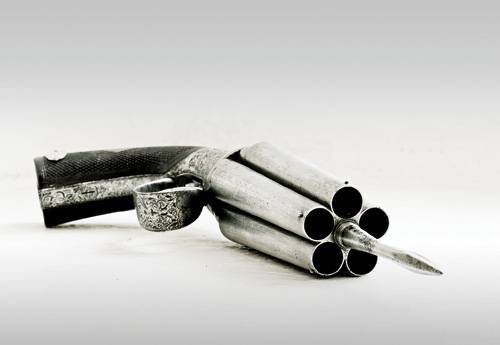
A man has always dreamed of killing two birds with one stone. And it’s better not two, but twenty at once. Therefore, the manual rifle weapon overgrown with trunks, like a hedgehog - with needles. Appeared guns like "duck paw", double-barreled guns, multi-barreled machine guns. As a result, evolution came to multiply single-barrel weapons, but there was another forgotten branch in it, the creatures of which were not very functional, but very beautiful. Name them - PepperBox.
If you literally translate the word "pepperbox" from English, you get "a box of pepper", or "pepperbox". This word was applied at first to any multiple-shot pistols - even to ordinary single-barreled revolvers. But it took root precisely in relation historical monsters, resembling either a huge revolver, or a small machine gun.
Pepperbox - is a multi-barreled pistol with a rotating block of barrels. He doesn’t have a drum as such, but it has a hinge for a half-revolver. Pepperboxes were charged from the side of the barrel - like antique flint pistols, but later structures appeared closer to the revolver, with a flip mechanism and access to the breech. Pepperboxes appeared in the UK and the USA around 1780 – 1800, and quickly spread throughout the world. Almost every arms firm can boast at least one pepperbox model. Moreover, many private traders, trying to outdo their competitors more seriously, created such constructions that it is fit to call them mutants, freaks, or even more successful.
According to the traditional scheme, the peperbox had six short trunks screwed into a rotating block. Common were the seed shelf and the flintlock. Naturally, at first, the barrel assembly didn’t turn around on its own, it was rotated by hand (and gloved, since the barrel that had just “worked” had a very uncomfortable temperature for the skin].) Moreover, each time it was necessary to sprinkle powder on the shelf compared to conventional double-barreled pistols practically to nothing.
■ MULTIPLICATIONS in the European style were made in Russia - mostly private masters. The Tula Arms Museum houses some 20-like guns.
There are no features in these pistols: PepperBoxes were not characteristic of the Russian weapon tradition, rare specimens are replicas of European and American models.
Flintlock seriously limited the possibility of PepperBox. But the appearance of the capsule lock gave a new impetus to this direction. First of all, the proto-revolver (sometimes Pepperboxes are called and so) with the capsule lock had the advantage of continuous firing.
The classic revolver, familiar to us from Westerns, appeared in the first half of the XIX century. As is well known, the famous Samuel Colt did not invent it, but perfected it by adding an automatic spinning device to the balan after each shot. This invention, coupled with the production of revolvers put into production (since 1836), doomed the Pepperboxes to death, not allowing them to even be truly born.
 ■ FAMOUS MODERN traumatic pistol 4-1 ML Osa can also be referred to as peperboxes. True, the tiny pistol has no rotating parts, but there are as many as four barrels. "Wasp" refers to the "firearms without a barrel" family of weapons - it is allowed to civilian circulation in the territory of the Russian Federation. The "Osu" uses an 18x45 cartridge with a rubber bullet with a diameter of 15,3 mm, and the primer is initialized not by a striker but by an electric current. The effect of hitting a bullet from the "Wasp" can be compared to a punch of a heavyweight boxer.
■ FAMOUS MODERN traumatic pistol 4-1 ML Osa can also be referred to as peperboxes. True, the tiny pistol has no rotating parts, but there are as many as four barrels. "Wasp" refers to the "firearms without a barrel" family of weapons - it is allowed to civilian circulation in the territory of the Russian Federation. The "Osu" uses an 18x45 cartridge with a rubber bullet with a diameter of 15,3 mm, and the primer is initialized not by a striker but by an electric current. The effect of hitting a bullet from the "Wasp" can be compared to a punch of a heavyweight boxer.But, as mentioned earlier, many firms wanted to come up with something constructively new and improve the classic Colt, which, frankly, was almost perfect at that time. This is how the second-generation bunderrevolvers appeared.
The second generation
The first capsule pepperbox was patented simultaneously with the first Colt revolver - in 1836 year. The creator of it was the Massachusetts businessman and gunsmith Ethan Allen. At that time it was not yet clear which concept would conquer the market - many rotating barrels or one barrel with a rotating drum. Allen believed in PepperBox and at first was almost not mistaken. Allen's PepperBox was launched in 1837 and was a success. True, not in the legendary Wild West, which at that time was just beginning to be mastered, but in the eastern part of the country. Gunfighters with Allen's bundelrevolver could be found as often as armed with the classic Colt cannons. The menacing, heavy, clumsy look of this weapon played a significant role: the numerous holes of the barrels frightened much more than one "pitiful" barrel of a revolver.
Allen's pistols, like modern revolvers, had a double action capsule lock. Pressing the trigger and carried out a platoon, and turn the barrel unit, and a shot. There were several modifications of Pepperbox Allen - with calibers from 31 to З6-th and a different number of trunks (up to six).
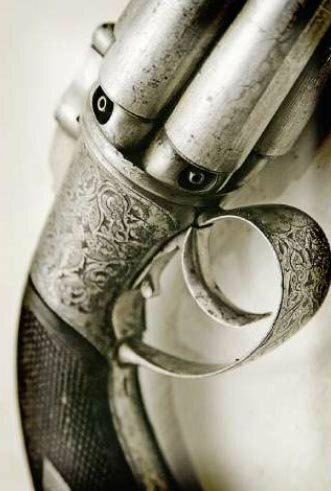 At about the same time as Allen in Europe, another pepperbox was patented - the Belgian Marriette. Europeans were not as conservative as the Americans. Marriette made Pepperboxes with the number of barrels from 4 to 24 (!). Several copies of the last freak preserved to our times - sometimes they pop up on various online auctions and go for? 15-20 thousands apiece. It is difficult to imagine how to hold an 24-barrel gun in one hand: even an ordinary automatic pistol noticeably pulls to the ground.
At about the same time as Allen in Europe, another pepperbox was patented - the Belgian Marriette. Europeans were not as conservative as the Americans. Marriette made Pepperboxes with the number of barrels from 4 to 24 (!). Several copies of the last freak preserved to our times - sometimes they pop up on various online auctions and go for? 15-20 thousands apiece. It is difficult to imagine how to hold an 24-barrel gun in one hand: even an ordinary automatic pistol noticeably pulls to the ground.By the way, in order to charge a pistol made under Marietta's patent, it was necessary to unscrew each barrel separately and put the cartridge in it from the breech part. Allen Pepperboxes were easier to use: it was possible to simultaneously remove the entire block of trunks.
In addition to the degree of intimidation of the enemy, the Europeans paid attention to design. Both Marriette and other European Pepperbox boxes were decorated with spectacular patterns, sometimes gilded, and the descent was made in the form of a ring, not a hook. Actually, like Marriette, bundelrevolvers were produced by all and sundry, and in the collections a fair number of samples remained, similar to the model of Marietta, but poorly identifiable.
English gunsmiths preferred the Allen system. It is understandable - hardly the British would have borrowed something Belgian. Allen did not have time to track copyist his development.
All bundel-revolvers, as one would expect, were distinguished by a high rate of fire for their time [naturally, with long recharging], but at the same time low accuracy of the fight due to the tight trigger mechanism and poor balance and were suitable for shooting only at short distances. They were used as a weapon of self-defense, while the revolvers of Colt and other gunsmiths were bought in huge batches, for example, by the army.
In addition to Allen and Marietta, it is worth mentioning several other leading producers of peperboxes from the first half of the 19th century — these are the British firms Cooper and Turner, as well as the Americans Blunt and Sime.
By 1870, almost all firms refused to have Pepperboxes. Even a fan of his own invention, Allen switched to the production of revolvers of classical design. Rare gunsmiths turned to the Pepperbox box, except to achieve maximum compactness of weapons: the location of the barrels right in the drum made it possible to cut the gun by the length of the barrel itself. But such cases were isolated.
Today the classic revolver seems logical and understandable to us. How could a Pepperbox box compete with him? The popularity of bundelrevolver-pepper shakers was also due to its visual power. Six, and even more trunks, looking at the enemy - it looks frightening. And it does not matter that only one of them shoots. After all, the psychological aspect of the popularity of a particular type of weapon plays a significant role.
 ■ Pepperbox was not necessarily a gun. For example, a short-barreled shotgun made according to the same principle is kept in the Tula Museum.
■ Pepperbox was not necessarily a gun. For example, a short-barreled shotgun made according to the same principle is kept in the Tula Museum.Monstrous freaks
However, gunsmiths could not stop on the Pepperboxes and revolvers. Everyone wanted to stand out and produce something new and even more deadly. So at various times there were pistols that could not be assigned to any of the categories at all.
For example, in 1860, the American manufacturer Jones produced an amazingly beautiful 10-barreled 36 caliber pistol. The trunks were located not in a circle, but in two columns of five pieces. On both sides there were two "dogs". Each new press on the trigger "clicked" the dog to the next trunk. Thus, the gun was fired alternately in a Z-shaped sequence: the first right barrel — the first left — the second right — the second left — and so on. Not so long ago, one of the copies of the PepperBox Jones was sold at auction for $ 9000.
In the same 1860-ies in France produced 30-charging double-barreled revolver 22-caliber. The drum of the revolver was a two-level one and immediately sent two cartridges into the upper and lower barrels; the shot was fired from both barrels simultaneously.
In the middle of the 19th century, the French firm Lefoshe produced several harmonica-type Pepperboxes. Six or ten “harmonic” barrels are located in the same horizontal row, and with each shot the row of barrels shifts relative to the percussion mechanism like a typewriter carriage. The main drawback of such a weapon was inaccuracy: when firing from sidetracks, it was monstrously difficult to keep the gun in a horizontal position.
There were also vertical "harmonics" - for example, firms Auslands. In such pistols, a block of four barrels moved vertically.
And in Cairo, in the Abdeen Palace Museum, a revolver is kept for all revolvers. The unique design based on an ordinary "Colt" is equipped with eight (!) Drums. As soon as one six-drum is consumed, the shooter turns a large ring with a special handle, replacing the drum with a new one, and the shooting continues.
Museum staff are inclined to believe that this is a local artisanalization of the "Colt" brought from the USA.
In addition, the PepperBox was actively used as a “hidden” weapon - for example, in a cane or even in the bicycle handlebar, in France, in 1880, this design was also used)! The fact is that the PepperBox scheme allowed us to “surround” any round or multi-faceted tube, such as the base of the blade, with the trunks, and hide the weapon in any suitable case.
These days pepperboxes are part of the story (although today many-barreled rocket launchers, made on the same principle, are also mass-produced. They can be found in movies, more often than not in westerns, but in genre stylizations in the spirit of steampunk and post-apocalypse. This is easily explained by the spectacular appearance of such weapons. But to be honest: if a Marietta pepperbox of the 19th century is directed at me in a dark lane, I’m unlikely to admire its magnificent exterior design and ring-shaped descent. Because weapons always remain weapons, no matter how they look.
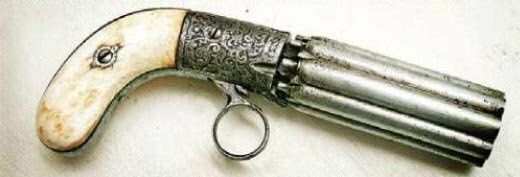
■ Marrieta Bundesrevolver
Country: Belgium Length: 184 mm N Barrel length: 71 mm Weight: 0,7 kg Caliber: 9,6 mm Cut-outs: no Magazine capacity: 6 cartridges N Starting speed of the bullet: 152 m / s

Multiple revolving pistol with capsule ignition design Jules Marietta. In the 1839 year (the 1837 is sometimes indicated the year when the first samples were actually created, but the patent dates back to 1839.] Each barrel has four rectangular recesses in the barrel in order to make it easier to remove with a special key. The barrels are screwed to the spindle on the fixed breech, access to which is provided by a hole in the center of the barrel. First, when the trigger was made in the form of a ring, the barrel block was turned, placing the cap under the percussion mechanism. At the same time, the lower trigger was cocked, and with further tension of the ring trigger, he broke off the platoon and hit the cap, resulting in a shot.
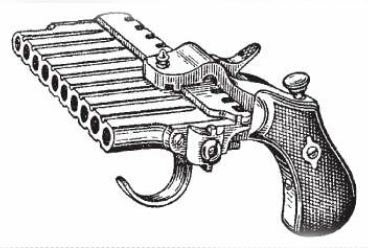
■ FRENCH PEPPERBOX TYPE "HORIZONTAL HARMONIC"
The ten “harmonic” trunks are arranged in the same horizontal row, and with each shot, the row of the trunks shifts relative to the percussion mechanism, like a typewriter carriage. It was very difficult to get into any of these weapons, as well as keep them from skewing. In addition, such a gun could be extremely small-caliber (0.22, for example} and was suitable only for self-defense at close distances.
■ JONS DESIGN GUN. USA, I860 YEAR Caliber - 0.36. Each "column" of trunks had its own dog, which "snapped" one division down after each shot. The pistol fired alternately in a Z-shaped sequence: the first right barrel — the first left — the second right — the second left — and so on. Last year, one of the instances of the PepperBox Jones was sold at auction for $ 9000.
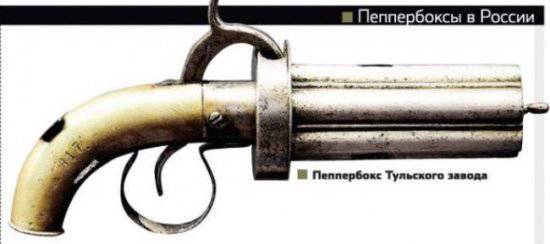
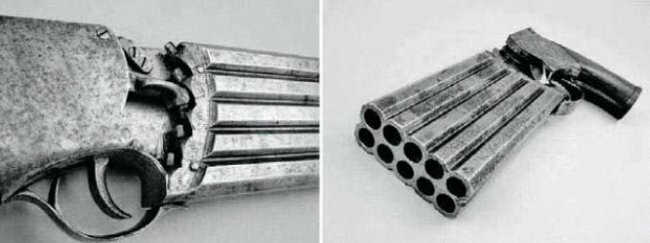
Information